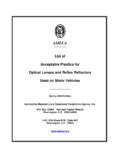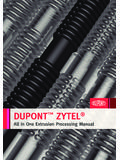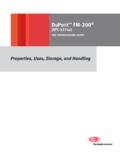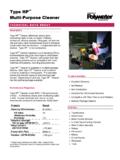Transcription of Safety at thermoforming machines PPS6(rev1)
1 Health and Safety ExecutiveHealth and Safety ExecutiveHSE information sheet1 of 6 pagesPlastics Processing Sheet No 6 (Revision 1) Safety at thermoforming machinesIntroductionThis information sheet is one of a series produced by HSE s manufacturing sector and gives practical advice for owners and users of thermoforming machines . It gives information on commonly accepted and practicable safeguards for significant hazards on thermoforming machines supplied before the publication of BS EN 12409:1999. This standard was replaced by BS EN 12409:20081 and represents state of the art for these machines . This guidance can also be used as a check for machines manufactured after 1999 to make sure that they meet the minimum levels of protection required. The main UK legal requirements covering the safe use of thermoforming machines are the Provision and Use of Work Equipment Regulations 1995, all new machinery has been subject to the European Machinery Directive, which requires machines to be safe by design and construction.
2 When first placed on the market or first put into service, machinery must meet all relevant Essential Health and Safety Requirements (EHSRs) in the Directive. The machine should be designed to the state of the art , and be accompanied by user instructions, a Declaration of Conformity, and bear a CE marking. Further guidance on the Directive and the UK Supply of Machinery ( Safety ) Regulations is available from HSE s website and in Buying new standardsThe information contained within this guidance is split into three sections: safeguards that apply to both manually loaded/unloaded and in-line machines ; additional safeguards for manually loaded/unloaded machines ; additional safeguards for in-line tables below list the practical safeguards that can be applied. Current standards are quoted to illustrate acceptable levels of Safety . Where the publication date of standards is after the machine manufacturing date you should ensure that standards that were current at the time of manufacturing are met.
3 For pre-1995 machinery, safeguards that meet PD 5304:20054 are acceptable alternatives to the more recent BS ENs that apply to both manually loaded/unloaded and in-line machinesTable 1 Hazards and principal safeguards for manually loaded/unloaded and in-line machinesHazardSafeguardUnintended gravity descent of raised partsAll thermoforming machines should have in place effective devices to prevent unintended gravity descent of raised machine parts in the event of failure of the machine s energy supply or loss of hydraulic or pneumatic fluid. machines manufactured since 1999 should have these fitted as required by the European formal industry agreement was signed in January 2003 to address the risks of unintended gravity descent of raised machine parts of thermoforming machines as defined in BS EN 12409. Users of existing machines in January 2003 agreed to check and, where necessary, modify machines to incorporate effective devices for preventing unintended gravity descent of raised machine parts in the event of power failure or loss of hydraulic or pneumatic fluid.
4 All modifications should have been completed by 31 December and Safety Executive2 of 6 pagesMovement of drape table at base of machineFixed guards, or drape table movement control interlocked with access door. (It is possible to connect the bottom access door to the operator s guard interlocking system.)Heater bankTrapping by heater unit(s) will be prevented by the guarding arrangements specified for elsewhere on the machine . To control the fire risk, the movement of the heater should be interlocked with the opening of the guard so that opening the guard causes the heater to return to its rest/rear feedMechanical hazard at the intake (eg transmission machinery, nips at powered rollers, braking mechanisms) should be protected by fixed/interlocked guards (single-channel with one position sensor) or other effective surfacesHot parts above 80 oC need to be protected against accidental contact using guards or insulation.
5 Where hot parts are necessarily exposed (eg moulds) warning signs are safeguards for manually loaded/unloaded machinesTable 2 Hazards and additional safeguards for manually loaded/unloaded and in-line machinesHazardSafeguardForming section: machines that can be manually loaded and/or unloaded. Traps at the drape/table/plug/clampEither: dual-channel interlocking with one position sensor in each channel (this may be control interlocking); or guard-inhibited power interlocking; or photo-electric systems. The use of control guards (ie where closing the guard initiates platen closure) is acceptable on all thermoforming machines except for those where there is sufficient space for a person to stand between the operator s guard and the above standard applies unless the only powered motion is that of the drape table and/or heater battery.
6 In such cases, two-hand control (with fixed guards at sides and rear) is acceptable. Where clamp frames are brought down with the guard open to hold the material, a facility for two-stage clamping under low pressure should also be safeguards for in-line machinesTable 3 Hazards and additional safeguards for in-line machinesHazardSafeguardForming section: in-line machines drape table/plug/clampSingle-channel interlocked guards operating in the control circuit to prevent dangerous movement when the guard is and Safety Executive3 of 6 pagesCutting/trimming unitInterlocking as for forming section. Also access to the blade through the discharge opening should be prevented by: safe design of the cutting device; or a distance guard, eg a tunnel guard; or a take-off device interlocked to the control system (single positively operated position switch) to prevent movement of the cutting device when the take-off device is unit Single-channel interlocked guards operating in the control circuit to prevent dangerous movement when the guard is the take-off device is removable and there is access to cutting/stacking units, the device should be interlocked (single positively operated position switch) to the control system to prevent any dangerous on setting proceduresA written safe system of work for tool changing and setting should be devised in consultation with your setters, based on the following: No mould-changing, setting or try-out operation should be undertaken without first checking that the platens/moulds will not move when the operator s guard is open.
7 The industry agreement to prevent unintended gravity descent of raised machine parts requires devices to be in place to prevent this happening. You should ensure that devices provided are used. If the table or the cutting head is in the raised position measures should be in place to prevent unintended gravity descent. Isolation requirements will depend on the machine size and type, as well as on the length of the tool change procedure. Advice by category is as follows: On small manual machines , with quick tool-changing facilities and where the setter is working outside the machine , there may be no need for power isolation when tool changing, and use of the operator s safeguards alone will be sufficient. On in-line machines , where the tool-change operation takes a relatively short period of time and the setter is either outside the machine or can be seen easily from the control panel, the emergency stop should be used in conjunction with the operator s safeguards.
8 On larger manual or in-line machines , where there is either a need to work between the tools/platens, or where the setter is out of view from the control panel, all power supplies should be isolated and locked off, and stored energy dissipated. It should be possible, in most cases, to remove all mould-securing bolts and pipework connections without requiring powered movement of the drape table. Using locating lugs on the table should ensure that the tool matches exactly the opening in the window frame . On machines where it is not practicable to change the mould, clean, fault-find etc without powered movement with the guards open, such operations should only be permitted if a suitable setting mode is provided that has been built into the machine controls. To be suitable, such facilities should include slow speed that does not exceed 25 mm/s with two-hand control or hold-to-run, which should be engaged automatically, on selection of the override Safety checklistRegular checks by the operator are a good way of identifying problems as well as making sure machinery is safe for use.
9 It is recommended that operator checks are carried out at regular intervals, as a suggestion daily or after mould changes. Table 4 contains the recommended minimum checks the operator should carry out on a regular basis. You may also want to consult the manufacturer s instructions to see if the operator should carry out any additional and Safety Executive4 of 6 pagesTable 4 Recommended minimum checks for the operator to carry outThe answer to all questions should be yes or action needs to be takenYe sNoAre all fixed and interlocked guards in place, in good condition and secure?Are all interlocking devices correctly aligned and securely attached to guards?Does opening an interlocked guard immediately stop the parts it protects?When an interlocked guard is open do all dangerous parts remain stationary if a start control is pressed?
10 Where time-delay interlocks are fitted do they prevent access until rotation of dangerous parts has stopped?Are fixed guards held in place with fastenings that require a tool to undo them?Where pressure-sensitive mats are fitted does the pressure-sensitive mat indicator work when the mat is stepped on?Do any trip devices function correctly?Are all control unit enclosures closed, locked and the keys removed?Where two-hand controls are provided do both buttons have to be pressed together for the machine to operate?Where hold-to-run controls are provided if you release the button does the machine stop?Where fitted, are adjustable guards adjusted correctly?Are Safety devices, interlocks and guards free from evidence of being tampered with?Does the heater return to its rest or rear position when the interlocked guard is opened?If an electro-sensitive curtain is fitted, when the machine is at rest does breaking the curtain with the test piece cause the indicator to change state?
















